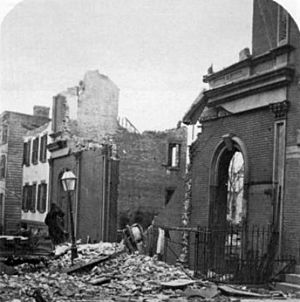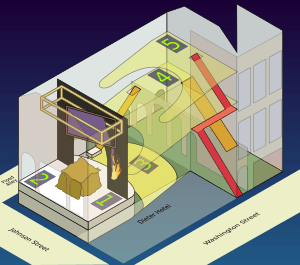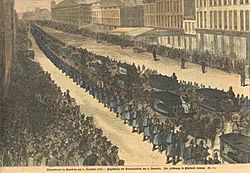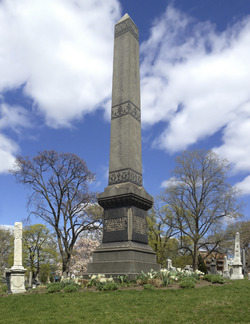Brooklyn Theatre fire facts for kids

Brooklyn Theatre from Johnson Street, shortly after December 5, 1876, fire
|
|
| Date | December 5, 1876 |
|---|---|
| Time | About 23:20 local time |
| Location | the site of what is now 271 Cadman Plaza Brooklyn, NY 11201 United States |
| Casualties | |
| 278–300+ (estimated range) | |
The Brooklyn Theatre fire was a terrible fire that happened on the evening of December 5, 1876. It broke out at the Brooklyn Theatre in the city of Brooklyn, which is now a borough of New York City. Over a thousand people were watching a play that night.
The fire killed at least 278 people, and some reports say more than 300 died. Many victims could not be identified. They were buried together in a common grave at Green-Wood Cemetery. A tall stone monument marks their resting place. Other identified victims were buried in different parts of the Cemetery of the Evergreens.
This fire is one of the deadliest theatre fires in U.S. history. Only the 1942 Cocoanut Grove fire and the 1903 Iroquois Theatre fire had more deaths. Most people died in the "family circle," which was the highest level of seats and the cheapest. This area got very hot and filled with thick smoke quickly. There was only one stairway to escape, and it became blocked with people. This trapped more than half of the people in that section.
The Fire Begins

On Tuesday evening, December 5, 1876, about a thousand people were at the theatre. About 400 people were in the family circle, the highest seating area. Others were in the dress circle and the lower floor seats.
The play was going well until around 11 p.m. This was during the break between the fourth and fifth acts. The main curtain was down, hiding the stage. The orchestra was playing music. Some people in the audience heard strange noises from behind the curtain. It sounded like a fight or machinery working.
Behind the curtain, actors were getting ready for the next scene. This scene was set in an old boathouse. The set was made of painted canvas on a light wooden frame. Actors Kate Claxton, J. B. Studley, and H. S. Murdoch were already on stage. Kate Claxton, playing a blind orphan girl, was lying on some straw.
Actors Try to Help
At first, actors like Kate Claxton, H. S. Murdoch, and J. B. Studley tried to calm the audience. They told everyone to stay seated and be calm. The head usher, Thomas Rocheford, also tried to stop people from rushing out. Many people did calm down and sat back in their seats.
Charles Vine, who was in the family circle, thought Kate Claxton was very brave. He said she came out with J. B. Studley and told everyone the fire would be out soon. She looked very pale but stood strong.
The Brooklyn Daily Eagle newspaper reported that Claxton said, "There is no danger; the flames are a part of the play." This was not true, as fire was not part of the story. But as she spoke, a burning piece of wood fell near her. She gasped in alarm. This made the audience realize the danger was real, and panic exploded.
The actors kept trying to calm the crowd. J. B. Studley told them, "If I can stand here between you and the fire, you should be able to leave quietly." Kate Claxton repeated this message. The stage manager, J. W. Thorpe, also appeared and urged everyone to leave in an orderly way. But the audience was now completely panicked and ignored them.
Kate Claxton later remembered that they were almost surrounded by flames. It was too dangerous to stay. She tried to get Mr. Murdoch to leave with her, but he seemed confused and went back to his dressing room, where the fire was already burning. She realized jumping into the orchestra pit would only add to the struggling crowd.
Claxton found a secret passage from the leading lady's dressing room. It led through the basement to the box office. She and another actress, Maude Harrison, used this path to escape. Murdoch and Claude Burroughs thought they had time to get their regular clothes from their dressing rooms. It was December, and their stage costumes were thin. They got trapped and did not escape. Some actors and stage hands left through doors on Johnson Street. However, the fire on stage quickly spread, blocking those exits. All other exits were at the front of the theatre.
Escaping the Theatre
While the actors tried to calm the audience, the head usher, Thomas Rocheford, went to the back of the auditorium. He wanted to open a special exit door that led to Flood's Alley. This was one of three special exit doors designed by the architect. These doors were rarely used, so the lock was rusty. He struggled but finally managed to open the doors with a small piece of metal.
Opening these doors helped people on the main floor escape the building quickly. However, this action also had a negative effect. The open doors created a draft, which fed the fire on the stage. The flames immediately grew much stronger.
After the Fire
Rescue teams could not enter the building until the next morning. Most of the theatre had fallen into the cellar and burned until only ashes remained. What looked like a pile of rubble in the cellar turned out to be mostly human remains. A large group of people had fallen into twisted positions and then burned. These were mainly from the gallery and the stairway above the vestibule.
Removing these remains took about three days. It was hard to get an exact count of the bodies because forensic science was not advanced back then. By December 8, the coroner reported that 293 bodies had been removed. However, this number changed later. His own report later said 283 deaths. The memorial stone at Green-Wood Cemetery mentions 278 deaths.
Kate Claxton wrote about the fire nine years later. She said:
We thought we were acting for the best in continuing the play as we did, with the hope that the fire would be put out without difficulty, or that the audience would leave gradually or quietly. But the result proved that it was not the right course ... The curtain should have been kept down until the flames had been extinguished ... Raising the curtain created a draft which fanned the flames into fury.
—Kate Claxton, The New York Times, November 30, 1885
The fire greatly changed Kate Claxton's acting career. People started to connect her with any major fire that happened. She did not like this attention, but it also made her more famous. People were curious about "Kate Claxton, Fire Jinx."
A new theatre, Haverly's Theatre, was built on the same spot in 1879. But it was torn down 11 years later to make way for new offices for The Brooklyn Daily Eagle newspaper. In the mid-1900s, the area was redeveloped. Washington Street, Flood's Alley, and the site of the fire were all changed. Now, Cadman Plaza is there. The New York Supreme Court Building is close to where the theatre once stood. Today, a park occupies the exact site of the fire.



